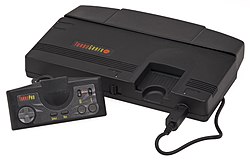
Back توربو غرافيكس-16 Arabic توربوجرافكس-16 ARZ PC Engine AST PC Engine Breton PC Engine Catalan TurboGrafx-16 Czech PC Engine German PC Engine Spanish توربوگرافاکس-۱۶ Persian PC Engine Finnish
This article needs additional citations for verification. (May 2023) |
  | |
  North American TurboGrafx-16 (top) and the original Japanese PC Engine (bottom) | |
| Manufacturer | NEC Home Electronics |
|---|---|
| Type | Home video game console |
| Generation | Fourth |
| Release date | |
| Lifespan | 1987–1994 |
| Discontinued | |
| Units sold |
|
| Media | HuCard |
| CPU | Hudson Soft HuC6280 @ 7.16 MHz |
| Memory |
|
| Display | Composite or RF TV out; 565×242 or 256×239, 512 color palette, 482 colors on-screen
|
| Graphics | HuC6270 VDC, HuC6260 VCE |
| Sound | Hudson Soft HuC6280, PSG, 5 to 10 bit stereo PCM |
| Successor | |
The TurboGrafx-16, known as the PC Engine[a] outside North America, is a home video game console designed by Hudson Soft and sold by NEC Home Electronics. It was the first console marketed in the fourth generation, commonly known as the 16-bit era, however in actuality, the console has an 8-bit central processing unit (CPU) coupled with a 16-bit graphics processor, effectively making the claim somewhat false advertising. It was released in Japan in 1987 and in North America in 1989. In Europe[2] the Japanese model was unofficially imported and distributed in the United Kingdom[3] and France from 1988. In Japan, the system was launched as a competitor to the Famicom, but the delayed United States release meant that it ended up competing with the Sega Genesis and later the Super NES.
The console has an 8-bit CPU and a dual 16-bit graphics processing unit (GPU) chipset consisting of a video display controller (VDC) and video color encoder. The GPUs are capable of displaying 482 colors simultaneously, out of 512. With dimensions of just 14 cm × 14 cm × 3.8 cm (5.5 in × 5.5 in × 1.5 in), the Japanese PC Engine is the smallest major home game console ever made.[4][5] Games were released on HuCard cartridges and later the CD-ROM optical format with the TurboGrafx-CD add-on. The "16" in its North American name and the marketing of the console as a 16-bit platform despite having an 8-bit CPU was criticized by some as deceptive.[6]
In Japan, the PC Engine was very successful. It gained strong third-party support and eventually became the Super Famicom's main rival. However, the TurboGrafx-16 failed to break into the North American market and was a commercial failure, which has been blamed on the delayed release and inferior marketing.[7] In Europe, the Japanese models were grey market imported, modified, and distributed in France and the United Kingdom beginning in 1988,[3] but an official PAL model (named simply "TurboGrafx" without the "16") planned for 1990 was cancelled following the disappointing North American launch with the already-manufactured stock of systems liquidated via mail-order retailers.[8]
At least 17 distinct models of the console were made, including portable versions and those that integrated the CD-ROM add-on.[9] An enhanced model, the PC Engine SuperGrafx, was rushed to market in 1989. It featured many performance enhancements and was intended to supersede the standard PC Engine. It failed to catch on—only six titles were released that took advantage of the added power and it was quickly discontinued. The final model was discontinued in 1994. It was succeeded by the PC-FX, which was released only in Japan and was not successful.
- ^ "Retro Sales Age Thread".
- ^ Cite error: The named reference
CVG130was invoked but never defined (see the help page). - ^ a b Cite error: The named reference
Agewas invoked but never defined (see the help page). - ^ Guinness World Records Gamer's Edition (2008)
- ^ McFerran, Damien (November 2, 2012). "Feature: The Making of the PC Engine". Nintendo Life. Archived from the original on July 30, 2019.
- ^ Therrien, Carl; Picard, Martin (April 29, 2015). "Enter the bit wars: A study of video game marketing and platform crafting in the wake of the TurboGrafx-16 launch". New Media & Society. 18 (10): 2323–2339. doi:10.1177/1461444815584333. S2CID 19553739.
- ^ Nutt, Christian (September 12, 2014). "Stalled engine: The TurboGrafx-16 turns 25". Gamasutra. Archived from the original on June 27, 2017.
- ^ Sartori, Paul (April 2, 2013). "TurboGrafx-16: the console that time forgot (and why it's worth re-discovering)". The Guardian. Archived from the original on July 1, 2018.
- ^ Stuart, Keith; Freeman, Will (February 27, 2016). "Why Kanye West is right to recommend the TurboGrafx-16". The Guardian. Archived from the original on June 22, 2017. Retrieved December 25, 2017.
Cite error: There are <ref group=lower-alpha> tags or {{efn}} templates on this page, but the references will not show without a {{reflist|group=lower-alpha}} template or {{notelist}} template (see the help page).